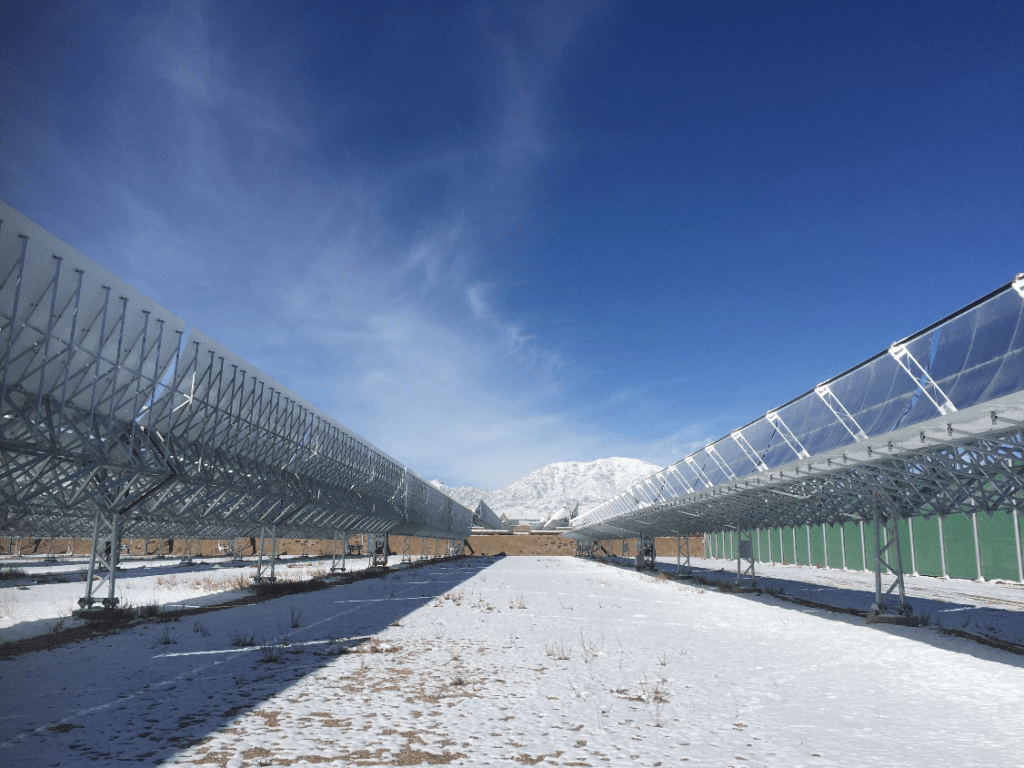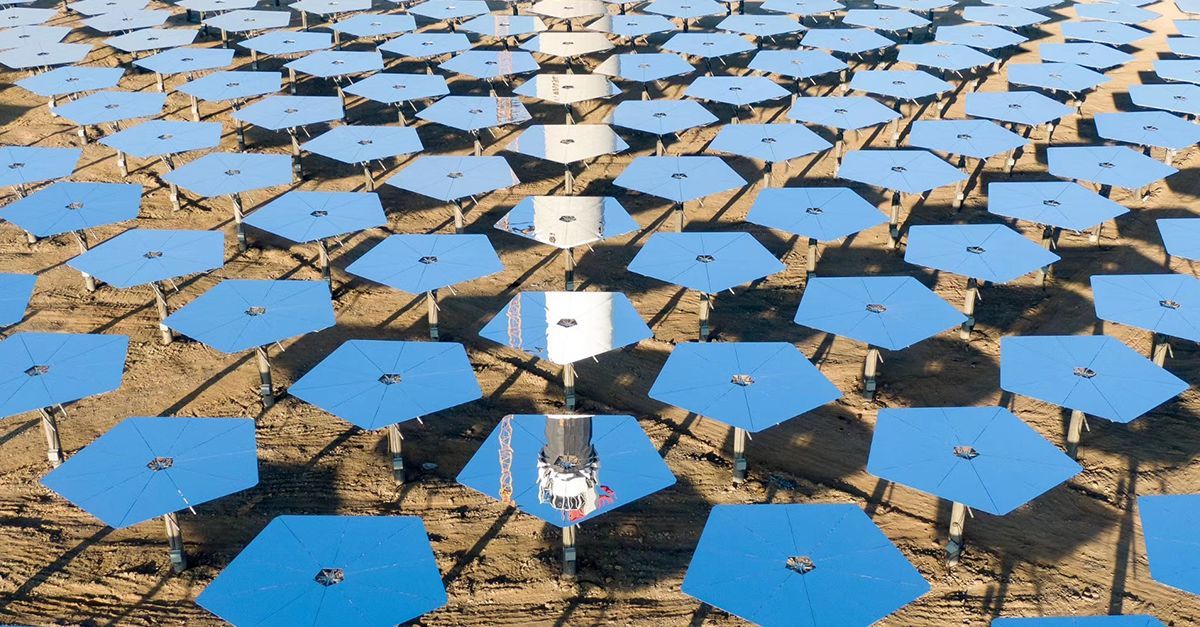In tower CSP, a solar field of mirrors or heliostats concentrate and reflect sunlight to a tower receiver
Cerro Dominador, a subsidiary of EIG Partners, has just bid the 450 MW Likana tower CSP plant it procured from SolarReserve several years ago at under 4 cents/kWh. Was the record low bid enabled by cost reduction in tower CSP heliostat solar fields? To learn the current status of heliostat technology, we checked with Gregor Bern who heads Group Concentrating Collectors and Optics at Fraunhofer ISE.
SK: I recall heliostats being $1.25 per square meter and hear they are lower now. Where are they today?
GB: The prices for heliostats have reduced a lot in the last 10 years. I think, we are somewhere about $80 per square meter now.
SK: Why do they still cost more than parabolic trough solar collectors?
GB: For parabolic trough system systems, we have a more standardized design since there are more deployed in the world already. The technology is more mature. While for the tower systems, there are just a few. So each tower project still contributes also to the learning on how to do it best. With every project for the tower systems up to now, you still have a very, very specific design for that particular plant.
SK: Was there similarly more variety of trough designs in its early years?
GB: So in the very beginning, there were a few different designs. But then with the beginning of the construction in Spain – so like the first real wave there, there was a well optimized design, the Eurotrough. That was deployed quite a lot. So there was there was one design that could be reused again. There was a licensed model and there still is actually from the same company as one of the Stelio consortium. They designed the Eurotrough collector and sub-license it to the different EPC. And also further optimized it for specific companies.
There were also more designs but they were all not so different. So that means that at least on the mirror side they could use the same kinds of mirror, the same shape, and the same sizes such that the mirror production companies could concentrate on a certain design and the different EPC could purchase them for their specific collector structure, but size and and shape were pretty much the same. So we had some kind of a standardized size in trough collectors.

The spb.de EuroTrough was selected for the solar field at the 100 MW Urat trough CSP project in China. IMAGE@spb.de
SK: Did repeating the same CSP plant size also cut costs for trough?
GB: The early trough plants in Spain were always about 50 MW because that size was required, so the first three were built that size. Our government in Spain said that with this size we have, we have experience so let’s just do it again and again and again.
So this made it quite mature because there were no large experiments in the size. So the more plants are built, the more learnings you would have and the cheaper you can organize and also design the whole plant.
SK: What are the ways heliostats are cutting costs?
GB: Most important is reducing the costs of the collectors themselves and this can be done by improving the control on the one hand such that you can use cheaper parts, like for instance cheaper drives.
And you can also reduce material in the structure of heliostats. This can be accomplished by smart design. For instance, the Stellio where you can reduce material by reducing the loads or the strength that the structure must provide. This is done by reducing the distance of the furthermost edge of the collector towards the center where it is carried.
And so this is the one direction. The other would be in production. You need to have mass production, you have to have a smart way of constructing the collector, maybe have a cheap assembly line. Not have so many different parts. You have to do pre-assembled manufacturing as far as you can.
If you can create heliostats that do not need a power supply by cable, but that can be self-powering by a little PV panel, for instance, and when you have wireless control transmission, then you can reduce the costs for all the cabling, for instance. This is the strategy that BrightSource follows for their heliostats. I think this more and more will more be used.
This is also very important for the small heliostats because there are you have many, many, more different heliostats that you would need to connect. With the larger heliostats, this may play a smaller role but nevertheless this is still a chance to reduce costs when you use a wireless communication and and self-powering heliostats.

Stellio Heliostats at the 50 MW Hami tower CSP project in China IMAGE@spb.de
SK: Will larger or smaller heliostats be the winner do you think?
GB: There has been quite a controversy about this. There are two different philosophies. One is building really large heliostats with very strong foundations and strong drives. And the other strategy is to go for small heliostats with a lighter design. And both paths are still undertaken, still viable. There’s some companies which concentrate on the very, very large heliostats and some go more to the smaller ones. So we have a variety of let’s say from about 20 square meters to up to 120 square meters.
But this divergence is a huge liability. A big challenge depending on location is to keep the reflectivity up when the plant is running. So you need to invest a lot in cleaning the heliostats regularly because every every bit of dust on the surface will reduce the light that can be focused to the receiver. So here we have one large challenge to optimize the right cleaning machinery. But then, on the other hand, we have all these different heliostat technologies.

BrightSource heliostats at the 392 MW Ivanpah tower CSP project in California IMAGE@NREL
SK: Are there any challenges in integrating heliostats with receivers?
GB: If we concentrate too much light to the receiver; the receiver overheats, then it can be destroyed and result in the plant being shut down. So you have to be very careful, not to concentrate too much energy on a single spot. Therefore, your heliostats have to be very precise. You have to have good controls.
The heliostat fields are optimized for a certain weather scenario and certain irradiance, and there would always be a group of heliostats that is not concentrating to the receiver, or most of the time, at least. For if a cloud passes, then more heliostats can be aiming to the receiver, to keep the temperature up. And when the cloud disappears, again, the number of heliostats focusing on the receiver reduced again, to not overheat.
Right now the problem would be on the receiver side. But once we have materials in the receivers that can withstand much higher temperatures, I think that will be also an important research topic in the future.
SK: What still needs work?
GB: I think there will always be some further improvements, very tiny improvements, both in the production but most probably also in the controls. But these improvements also have to go along with deployment because we can optimize and optimize and some gain will always be there, but we also need to gain experience in the plants, in running them. To have it be as bankable as trough you need more and more plants and show that the technology is there, that the technology is already available.
We will need not only power production for electricity but also other processes where you need higher temperature heat like industrial applications, where you need heat for chemical reactions. For instance, for hydrogen production. This has not been so much the focus so far. But this will be also an application that we see more and more in the future.
Then we could also again have a new challenge for even more precise heliostats that can focus better on a single point to raise the temperatures again. So for these very high temperature processes, we need work. But for power production, the technology is there and can be used already. And it is showing also in recent CSP plants.
SK: Like the record-breaking low cost tower CSP built in Morocco and Dubai?
GB: The costs are not public. But we do know the promises or the calculations from other researchers or developers when they present their designs that can be sub-licensed. This is public information. Whether in the end of production, this is exactly the price that is met, this is not so sure. But this is at least the direction. So we can infer.
SK: So heliostats are already contributing to lower cost commercial CSP?
GB: Yes, it is not a scientific topic anymore. It is now an industrial topic. So the technology is there and it can be used, but it must be deployed as well.
The post Did Heliostat Cost Cuts Help Likana Bid CSP Under 4 Cents? appeared first on SolarPACES.


